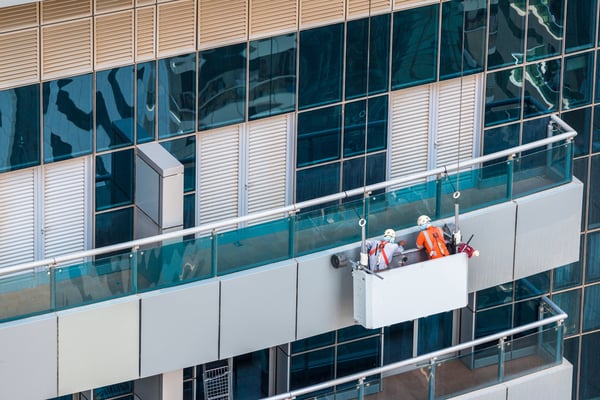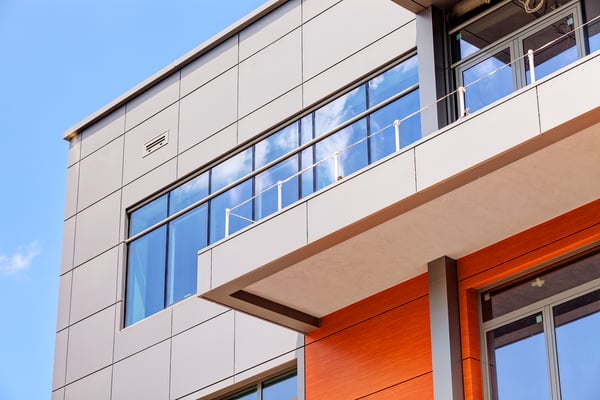Basic Principles of External Wall Systems

The main function of a building envelope or enclosure is creating a protection barrier for interior spaces and occupants. Construction professionals must integrate a multitude of materials, systems and components into the building envelope, to meet human needs while creating a functional assembly. The two most common threats that compromise the integrity and performance of a building envelope are uncontrolled rainwater penetration and moisture ingress.
Design a high-performance building envelope for your next construction project.
External Wall Systems: Basic Terms and Definitions
To understand the basic principles of building envelope design, the first step is getting familiarized with some key terms and definitions:
Exterior Cladding: A protective layer or finish attached to the exterior of a building enclosure. The term “cladding” is widely used to describe several building envelope materials, components and systems. Exterior cladding is in most cases the first defense barrier against bulk rainwater penetration.
Wet Zone: Refers to a section of the exterior wall system that is designed for exposure to the short- and long-term effects of bulk rainwater and moisture. The wet zone is typically located on the exterior of the innermost drainage plane of the assembly.
Dry Zone: Refers to the section of the exterior wall system that is not designed for exposure to moisture. The dry zone is typically located on the interior side of the innermost drainage plane of the assembly. Materials used for this zone have low moisture tolerance and minimal capacity to hold moisture.
Drainage Plane: Describes any element exposed to the weather or located between the wet and dry zones of an exterior wall system. Depending on the climate and wall specifications, the drainage plane can be specified as waterproof and vapor-impermeable, or water resistant and vapor-permeable. The drainage plane is designed to shed bulk rainwater and condensation downward and outward, preventing uncontrolled water ingress.

Air Barrier: Any element or feature that is designed to control air movements across an exterior wall system. Some key aspects for proper performance of the air barrier are the following:
- It must reside within the wall assembly, and be continuous from roof to wall to foundation.
- Using high-quality materials that provide resistance to air pressures without compromising their performance.
- Being durable and providing structural integrity through its life cycle.
Air Retarder: An element that resists or slows airflow across an exterior wall system, in some cases it can be incorporated into the air barrier.
Vapor Retarder: An element that controls and limits vapor flow across an exterior wall system. A vapor retarder within an exterior wall system must meet building codes and regulations, and designers should consider the material selection, occupancy, local climate and building location.
Insulating Element: Any element that is used to control and regulate heat transfer across an exterior wall system. Insulation elements are designed to minimize thermal bridging and condensation in the dry zones of the assembly. Those elements placed in the wet zone of an assembly should be designed to perform properly in the presence of water.

Structural Element: Any element designed to withstand live and dead loads that act on a structure. The loads present must be distributed effectively onto the structural frame.
Interface Condition: Lines of separation or transition between individual facade elements of an exterior wall system. Some examples are the perimeter lines of window openings, electrical conduit, plumbing lines and mechanical ventilation.
Flashing: Elements that collect, contain, and divert bulk rainwater to the exterior sides of a building envelope. These elements help keep water away from interior spaces and the wall system’s dry zone. End dams are elements that prevent water ingress at wall penetrations and building corners.
Moisture Management System: A combination of elements that control and manage the adequate distribution of moisture through an exterior wall system. The moisture management system deals with precipitation, air flow and diffusive vapor flow.

Storage Capacity: The ability of a material or element to safely absorb and hold moisture. Many materials used in exterior wall design and construction can safely hold a significant moisture level. However, some materials suffer moisture deterioration and failure over time, when exposed to repeated and prolonged wetting.
Diffusive Vapor Flow: This term describes vapor transfer through the layers of an exterior wall system. The rate and direction of diffuse vapor flow are affected by the interior and exterior ambient temperatures and relative humidities. The differences in vapor pressure and vapor permeability between layers also affect flow.
Capillary Action: This refers to the absorption of moisture into small voids in a material, until it reaches maximum capacity. Capillary action in wood products is a common issue that causes deterioration of exterior wall systems.
Wind-Driven Rain: The process by which rainwater is driven through an exterior wall system when exposed to wind loads. Water can flow through existing voids in the system, or voids that are created by deflection under external loads. Under extreme weather conditions, the wind itself can cause deflection.

Anuj Srivastava
Anuj Srivastava is a principal partner at NY Engineers. He is known for his MEP franchise market knowledge. Anuj is currently leading a team of 100+ MEP/FP engineers and has successfully led over 1500 franchise projects in the US.
Join 15,000+ Fellow Architects and Contractors
Get expert engineering tips straight to your inbox. Subscribe to the NY Engineers Blog below.

